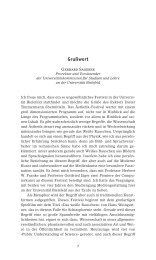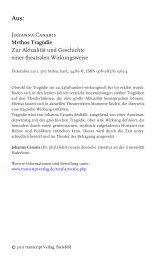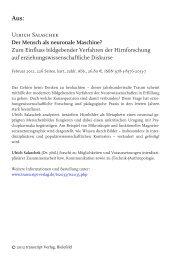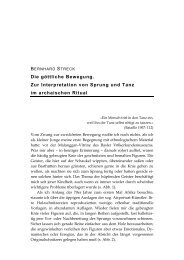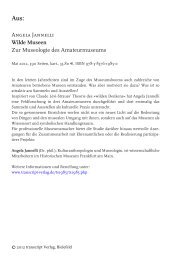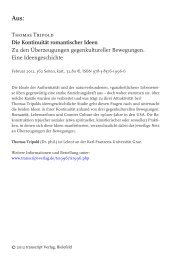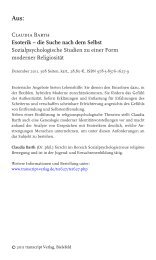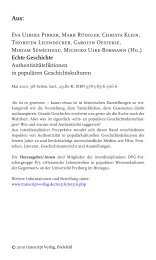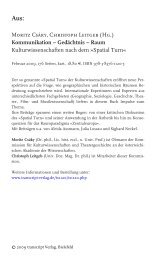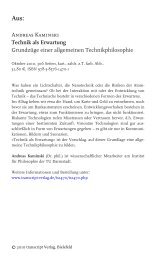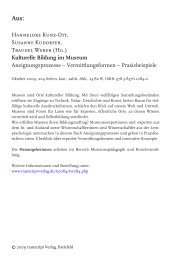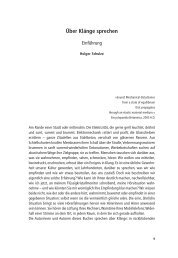Julia Straub (ed.) Paradoxes of Authenticity Studies on a Critical ...
Julia Straub (ed.) Paradoxes of Authenticity Studies on a Critical ...
Julia Straub (ed.) Paradoxes of Authenticity Studies on a Critical ...
Create successful ePaper yourself
Turn your PDF publications into a flip-book with our unique Google optimized e-Paper software.
Introducti<strong>on</strong><br />
The <str<strong>on</strong>g>Paradoxes</str<strong>on</strong>g> <str<strong>on</strong>g>of</str<strong>on</strong>g> <str<strong>on</strong>g>Authenticity</str<strong>on</strong>g><br />
JULIA STRAUB<br />
The paradox, the dilemma <str<strong>on</strong>g>of</str<strong>on</strong>g> authenticity,<br />
is that to be experienc<str<strong>on</strong>g>ed</str<strong>on</strong>g> as authentic<br />
it must be mark<str<strong>on</strong>g>ed</str<strong>on</strong>g> as authentic,<br />
but when it is mark<str<strong>on</strong>g>ed</str<strong>on</strong>g> as authentic<br />
it is m<str<strong>on</strong>g>ed</str<strong>on</strong>g>iat<str<strong>on</strong>g>ed</str<strong>on</strong>g>, a sign <str<strong>on</strong>g>of</str<strong>on</strong>g> itself, and<br />
hence lacks the authenticity <str<strong>on</strong>g>of</str<strong>on</strong>g> what<br />
is truly unspoil<str<strong>on</strong>g>ed</str<strong>on</strong>g>, untouch<str<strong>on</strong>g>ed</str<strong>on</strong>g> by m<str<strong>on</strong>g>ed</str<strong>on</strong>g>iating<br />
cultural codes.<br />
(JONATHAN CULLER, FRAMING THE<br />
SIGN)<br />
In Henry James’s novel The Golden Bowl (1904), Prince Amerigo<br />
goes shopping for a w<str<strong>on</strong>g>ed</str<strong>on</strong>g>ding present for his future bride with a former<br />
lover, Charlotte Stant. The pair comes across a “[s]imple but singularly<br />
elegant” (120) crystal bowl in a little curiosity shop, which the<br />
owner is keen to sell to them. But the two customers are not easily<br />
fool<str<strong>on</strong>g>ed</str<strong>on</strong>g> into paying a price they suspect is inappropriately high. “‘Gold,<br />
really gold?’” the incr<str<strong>on</strong>g>ed</str<strong>on</strong>g>ulous Charlotte asks, w<strong>on</strong>dering if the gold<br />
can be scratch<str<strong>on</strong>g>ed</str<strong>on</strong>g> <str<strong>on</strong>g>of</str<strong>on</strong>g>f (120-21). Her inkling that something must be innately<br />
wr<strong>on</strong>g with the bowl persists, disregarding the shop owner’s reassurances:<br />
“‘What is the matter with it?’” she asks him, “‘Of course I<br />
know something must be’” (122, emphasis in the original). Her compani<strong>on</strong>,<br />
Prince Amerigo, discerns its potential flaw more sharply: “‘Its<br />
beauty is its being crystal. But its hardness is certainly its safety. It



